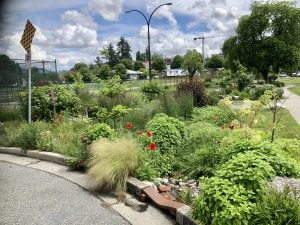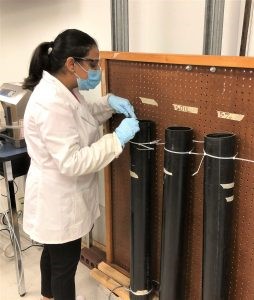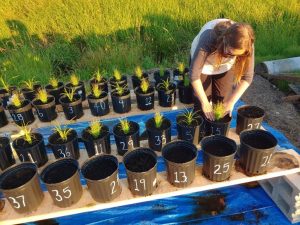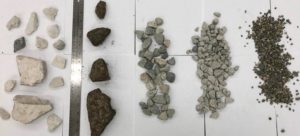Rain Gardens/Bioretention Cells – Water Quality Improvement

Stormwater runoff from roads and parking lots often contains toxic pollutant such as heavy metals, hydrocarbons and pesticides which may pose significant risks to biota in receiving aquatic systems. Recent study on the stormwater runoff quality of a BCIT Parking lot (Burnaby campus) showed pollutant concentration in stormwater exceeding the B.C’s Water Quality Guidelines for Aquatic Life, Wildlife and Agriculture by 10 to 100 fold. Such high levels of pollutants have negative impacts on the aquatic life in Guichon creek, which receives the stormwater runoff from the studied parking lots.
Green stormwater infrastructure (GSI) designs such as rain gardens, infiltration swales have often been used to improve the stormwater quality prior to discharge into the receiving water. Components of the GSI includes a soil layer which acts as a filtration media for capturing toxic pollutant. Although the raingarden soil or sand matrix in a typical GSI provides good removal of heavy metals, however, a recent studies conducted at BCIT found that the ability of the soil and sand layer to remove hydrocarbons (particular higher molecular weigh PAHs) is limited. There is a need to redesign the GSIs using a different filtration media to capture ALL types of toxic pollutant in stormwater, including hydrocarbons prior to discharge to receiving water.
Project: Biochar Amended Soil Matrix for Green Stormwater Infrastructure
Programs: Ecological Restoration, Civil Engineering, Chemistry, Chemical & Environmental Technology
An emerging technology for toxic removal from stormwater is the use of biochar as the filtration media. Biochar exhibit surface properties amenable for high sorption of many toxic contaminants, and may be a suitable sorption media in place of activated carbon. There is an increased interest in the use of biochar for organic and inorganic toxic contaminant removal in water, stormwater and wastewater. The precursor of biochar is biomass, typically derived from agricultural products (i.e., manure, wood chips, bamboo, corn). Biomass is converted to biochar at elevated temperature through pyrolysis or gasification. Unlike the production of activated carbon, the production of biochar does not undergo a physical or chemical activation phase during preparation, and can be produced from biomass readily available at lower temperatures. Thus biochar is more cost effective to produce and can potentially be an environmentally sustainable, cost effective technology for the removal of toxic pollutants in stormwater.
This is an ongoing biochar research program in the Dept. Civil Engineering, with collaborations with Dept. Chemistry, Dept. Chemical and Environmental Technology, and the Ecological Restoration Program. Previous biochar studies conducted by the same group at BCIT have shown promising results in biochar’s ability to remove pesticides, heavy metals and petroleum hydrocarbons in lab-scale experiments. There is a need to continue the research program to answer some key questions before the knowledge gained from lab-scaled studies can be transferred to a field-scale GRI design on BCIT campus, and a full-scale GRI design to be used by stormwater practitioners in British Columbia. The projects involved testing the response of native plants to various soil/biochar mixes to be used in rain gardens, the hydraulic properties of biochar/soil mixtures in rain gardens, the comparison of biochar with different physico-chemical characteristics in chemical contaminants removal efficacy, and the potential leaching of contaminants from spent biochar after use.


Bioretention Cell
Project: Bioretention Cell Water Retention Potential and Porosity Investigations
Programs: Civil Engineering, in collaboration with the City of Vancouver
Changes in land use due to urban development results in increases in impervious surfaces in an urban environment, resulting in decreased rate of rain water infiltration into soil and decreased evapotranspiration rates from natural vegetation, thus leading to increased runoff quantity and peak flow rates. The increased runoff quantity and peak flow lead to negative impacts on downstream aquatic ecosystems, bank erosion, channel incision, and deteriorating water quality, resulting in an overall negative impact on watershed health. Green storm infrastructures such as bioretention cells mimic natural water cycle by retaining, detaining and infiltrating rainwater where it falls, and through evapotranspiration from vegetation. Such systems are proven to mitigate the negative impacts of stormwater runoff from urbanized settings.

The design of bioretention cells requires proper selection of bioretention growing substrate and aggregates to maximize water retention and detention potential. This project investigated the retention potential of bioretention cells by measuring porosity of various aggregates used in the drain rock reservoir, and bioretention soil used to retain and remove stormwater pollutants. The project also investigated how soil porosity in the City of Vancouver bioretention cells changed over time, how addition of biochar in soil mix impacts porosity values, and how using recycled aggregates instead of standard aggregates will impact water quality.
Project: Data Collection and Analysis of Bioretention Cell/Green Infrastructure Sediment Pad Performance
Programs: Civil Engineering, in collaboration with the City of Vancouver
As part of the Citywide Integrated Rainwater Management Plan (City of Vancouver, 2016), this study evaluates the performance of sediment pads—pretreatment features within green infrastructure systems designed to capture sediment from stormwater runoff. Following a review of seven municipal design guides, including Vancouver’s draft standards, the study selected 19 concrete sediment pad sites for analysis based on field visits and the availability of maintenance data. Initial objectives focused on recommending pad size and maintenance frequency, but due to inconsistencies in sediment measurements, the scope was revised to emphasize data quality improvement, performance optimization, and design enhancement.
 Volumetric sediment loading was calculated from maintenance logs, and variables such as road classification, drainage area, slope, and rainfall were integrated from public datasets. ANOVA and Pearson correlation analyses were used to assess the relationships between site characteristics and sediment accumulation. Results informed targeted recommendations to improve monitoring, enhance sediment capture efficiency, and refine existing pad designs.
Volumetric sediment loading was calculated from maintenance logs, and variables such as road classification, drainage area, slope, and rainfall were integrated from public datasets. ANOVA and Pearson correlation analyses were used to assess the relationships between site characteristics and sediment accumulation. Results informed targeted recommendations to improve monitoring, enhance sediment capture efficiency, and refine existing pad designs.
Publication:
Jalizi, S., Ashley, K., & Chan, C. C. V. (2020) Restoration of an Urban Creek Water Quality Using Sand and Biochar Filtration Galleries. In Ecocities Now (pp. 161-173). Springer, Cham.
M.Sc Thesis:
Restoration of an Urban Creek Water Quality Using Sand and Biochar Filtration Galleries. (2019) Samira Jalizi. Supervisors: K. Ashley, C.C.V. Chan
Investigation of the Effects of Soil and Biochar in a Rain Garden on Stormwater Quality Improvement (2021) Ankita Mishra. Supervisors: K. Ashley, C.C.V. Chan
Research Reports:
Investigating soil and aggregate porosity of bioretention cells in the City of Vancouver. (2022) Spencer Pakulak. Supervisor: Colleen Chan. Collaborators: Sylvie Spraakman, Sophie Warren, City of Vancouver
Data Collection and Analysis of Bioretention Cell/Green Infrastructure Sediment Pad Performance in the City of Vancouver (2024) Jack Dai Tang, Madison McKellar. Supervisor: Colleen Chan. Collaborator: Sylvie Spraakman, City of Vancouver